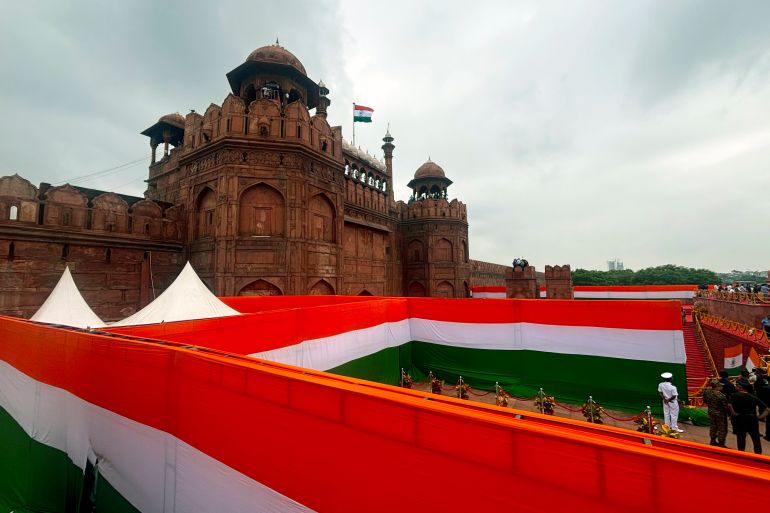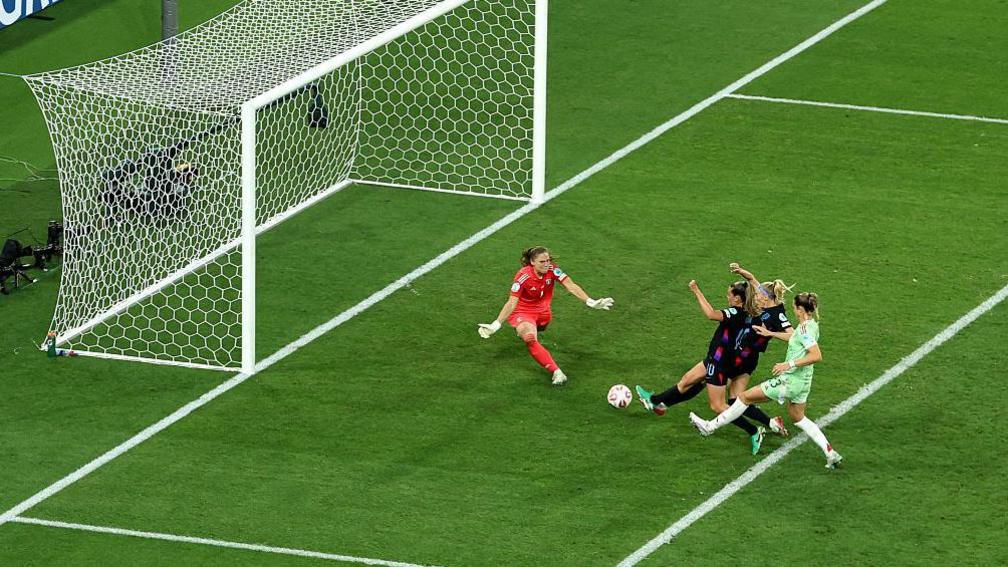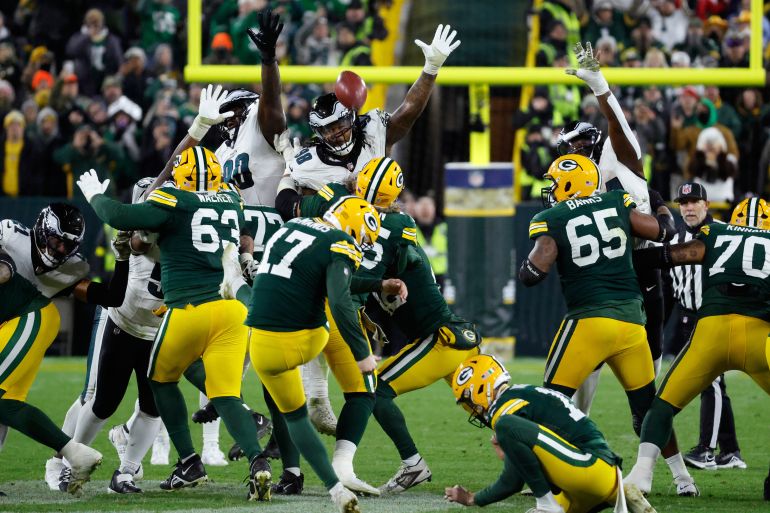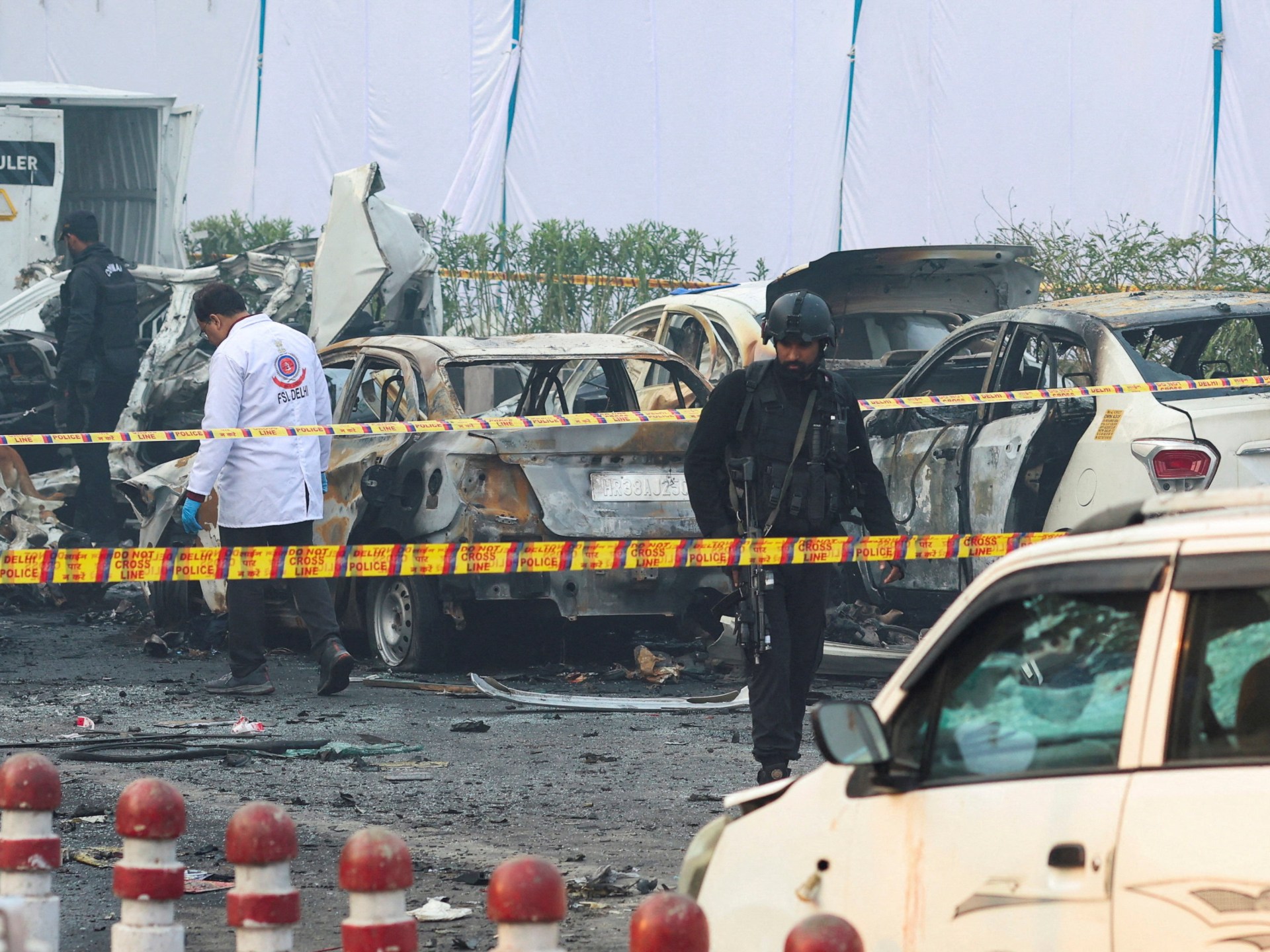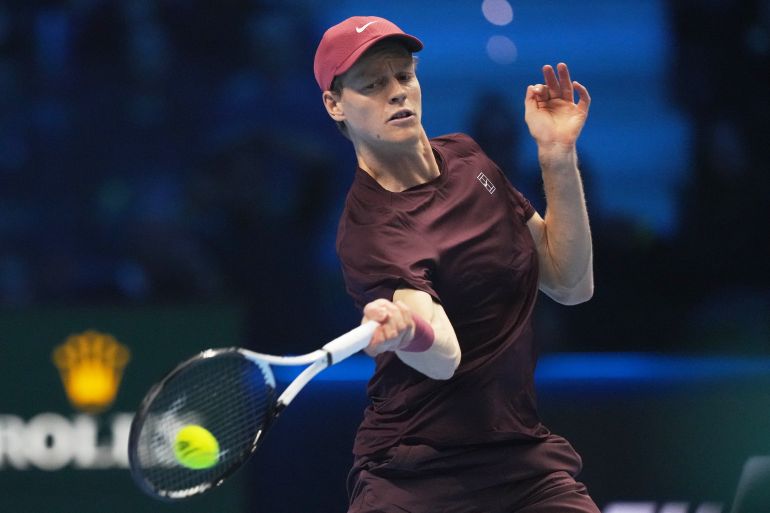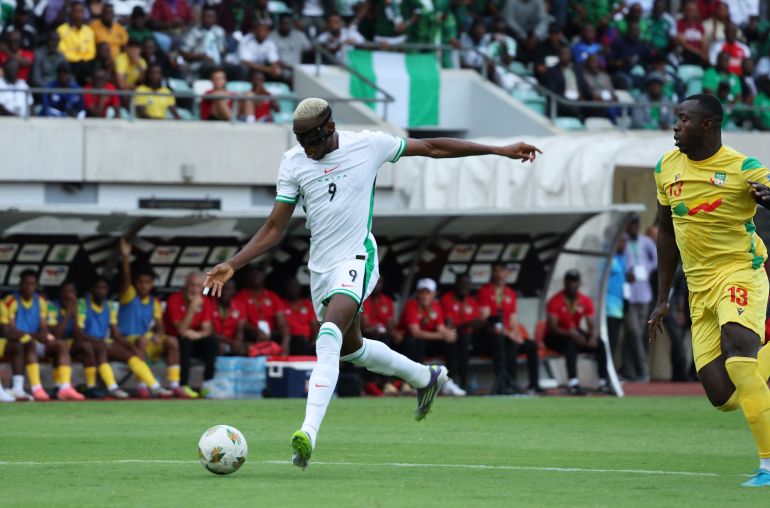At least 13 people have been killed and more than 20 wounded when a car exploded in New Delhi, India’s capital.
Security forces have been placed on high alert across major states and cities as authorities have launched an investigation into the cause of the blast on Monday night.
Recommended Stories
list of 1 itemend of list
What happened in New Delhi?
At 6:52pm (13:52 GMT), a powerful, high-intensity blast tore through a crowded neighbourhood during the evening rush hour.
According to Delhi Police, the explosion originated in a moving Hyundai i20 car.
“A slow-moving vehicle stopped at a red light. An explosion happened in that vehicle, and due to the explosion, nearby vehicles were also damaged,” Delhi Police Commissioner Satish Golcha told reporters.
Images from the scene show shattered windows, mangled vehicles, and fire and smoke rising from burning cars.
Police later detained the original owner of the car, identified as Mohammad Salman, in Gurugram, Haryana. He bought the vehicle in 2013. Investigators said Salman had subsequently sold the vehicle to another man in New Delhi who in turn sold the car recently. The person Salman sold the car to has also been arrested. However, the car was still registered in Salman’s name and carried a Haryana number plate, according to local media reports.
Delhi Police have invoked India’s primary “counterterrorism” law, registering a case under Sections 16 and 18 of the Unlawful Activities (Prevention) Act (UAPA) along with provisions of the Explosives Act.
This means that even though officials have yet to formally confirm the cause of the blast or name suspects, they appear to be treating the explosion as a potential act of terrorism, not just a criminal or accidental blast.
Where did the blast happen?
The explosion occurred in a densely populated part of Old Delhi near the Red Fort Metro Station.
The blast took place at a traffic signal close to the entrance of the metro station serving the Red Fort (locally known as Lal Qila), one of the city’s most renowned Mughal-era monuments.
The site lies at a busy intersection linking the Red Fort with the bustling Chandni Chowk Market, where the impact of the explosion was felt.
The Red Fort itself, constructed by Emperor Shah Jahan in 1546, is an architectural masterpiece that blends Islamic, Persian, Timurid and Hindu design traditions.
The Red Fort also holds deep national importance because it was from its ramparts that India’s first prime minister, Jawaharlal Nehru, delivered an Independence Day speech on August 15, 1947, marking the end of British colonial rule.
Since then, every year on Independence Day, the Indian prime minister hoists the national flag and addresses the nation from the same spot. This tradition makes the fort a living symbol of India’s sovereignty and freedom.
What’s the backdrop to the explosion?
The explosion occurred hours after police revealed they had arrested a Kashmiri doctor from Faridabad, also in Haryana, on charges of plotting a “terrorist” attack.
Haryana police said in a statement that they had found 2,900kg (6,393lb) of explosives, 20 timers, two dozen remote controls, a rifle and dozens of live rounds from the premises of the house where the doctor lived. Seven other people accused of helping the doctor were also arrested.
However, Indian authorities have so far not confirmed any link between the arrested doctor and the explosion on Monday.
What is the latest on the ground?
Police have intensified security checks across the city with a particular focus on railway stations, where incoming vehicles are being thoroughly inspected.
According to local media reports, major train stations across India – including those in Mumbai, the country’s financial capital, and in Uttar Pradesh, which borders Delhi – have also been placed on high alert as a precautionary measure.
Videos shared online show the wreckage of several cars scattered along a crowded street in Delhi’s old quarter as police moved in to secure the scene and disperse onlookers.
According to New Delhi’s deputy fire chief, the explosion ignited six vehicles and three autorickshaws.
Meanwhile, as authorities respond to the explosion, voters in the eastern state of Bihar are heading to the polls in the second and final phase of state elections, marking a significant political event unfolding alongside heightened national security concerns.

What have witnesses said?
As panic and confusion swept through Old Delhi after the explosion, witnesses described scenes of horror and chaos.
“Suddenly, there was a sound of a blast,” Irfan told Al Jazeera.
“We came running, and we didn’t get too close because we were scared. We saw someone’s hand on the ground. They were completely blown up.”
“I saw someone’s lungs, and I also saw a car’s steering wheel completely damaged. I just cannot express, can’t imagine how their families will deal with this. I cannot describe how big the blast was,” he added.
Relatives of people injured or missing were trying to track down their loved ones.
Speaking to Al Jazeera, Nazish Malik said his brother-in-law, Mohsin, an e-rickshaw driver, was missing after the blast.
“After more than 100 calls on his phone, finally someone answered and said that the phone is at the police post at the Red Fort and your relative has been taken to Lok Nayak Hospital,” Malik said.
“When we heard that, we rushed here and got here around 8:30pm. My brother was already here. I got here late but found that the security was so tight, they are not permitting us to go inside,” he added.
“At least announce who is critical and who is dead. You can at least inform that bit,” he said.

What have been the reactions?
Prime Minister Narendra Modi said he has been briefed about the attack by Home Minister Amit Shah and expressed condolences for the lives lost.
Condolences to those who have lost their loved ones in the blast in Delhi earlier this evening. May the injured recover at the earliest. Those affected are being assisted by authorities. Reviewed the situation with Home Minister Amit Shah Ji and other officials.@AmitShah
Shah said all possibilities were being investigated with top agencies involved.
Pained beyond words by the loss of lives in a blast in Delhi. My deepest condolences to those who have lost their loved ones. Have visited the blast site and also met the injured in the hospital. My prayers for their quick recovery.
Top agencies are investigating the incident…
Israel’s ambassador also expressed his condolences.
Heartbreaking scenes in Delhi following the car blast resulting in so many dead and injured. Our deepest condolences to the families of the victims. Wishing speedy recovery to those who survived.
Praise for the rescuers & security forces.
🇮🇱❤️🇮🇳
The embassy of Egypt likewise extended its condolences to the victims and their families.
On behalf of the People and Government of the Arab Republic of #Egypt, we extend our sincere condolences to the families and loved ones of those affected by the #RedFort blast. Our thoughts and prayers are with the bereaved, and we wish all injured a swift and complete recovery.
The United Kingdom issued a travel advisory after the explosion while the United States embassy in India released a security alert and extended its condolences.“Our sincere condolences to the families who lost their loved ones. We pray for the swift recovery of those injured,” the US government said.
India: On Nov. 10, a car exploded near the Lal Quila (Red Fort) metro station in central Delhi, India, with local media reporting multiple casualties.
While the cause of the explosion is unknown at this time, the Government of India has placed several Indian states on high alert.… pic.twitter.com/4E44MxxIkT
Has Delhi faced attacks in the past?
Yes, Delhi has been the target of multiple bombings and attacks over the years – but not in more than a decade.
- September 2011: Fifteen people were killed after a briefcase bomb exploded outside the Delhi High Court. The Pakistan-based armed group Harkat-ul-Jihad-al-Islami claimed responsibility.
- September 2008: The Indian capital was rocked by two sets of bombings. First, on September 13, five bombs ripped through crowded markets as people shopped for major festivals. The bombs killed 33 people. A group called the Indian Mujahideen claimed responsibility. Two weeks later, two more bombs exploded, killing three people.
- October 2005: Three blasts across different parts of the city killed 70 people. Pakistan-based Lashkar e-Taiba claimed responsibility.
- December 2001: Fighters from the Pakistan-based Jaish-e-Mohammed armed group attacked the Indian Parliament in a strike that brought the nuclear-armed neighbours to the brink of war. Thirteen people were killed.
- December 2000: Three people were killed in an attack at the Red Fort by Lashkar-e-Taiba fighters.
Have other places in India faced major attacks?
Yes, Indian cities have been targets of major attacks by armed groups, often associated with Kashmir’s secessionist struggle. India has in most cases blamed Pakistan-based armed groups and Pakistan’s intelligence services for orchestrating these attacks.
These armed groups have in several cases claimed responsibility themselves, and in some cases, Indian authorities have captured suspects.
Here are some of the deadliest attacks in India outside Delhi.
- November 2008, Mumbai: More than 170 people were killed and over 300 were injured in attacks carried out by Lashkar-e-Taiba. Indian authorities captured one of the perpetrators alive.
- July 2008, Ahmedabad: Seventeen bombs exploded in different parts of the western Indian city, killing 56 people. Police blamed two armed groups.
- May 2008, Jaipur: More than 70 people died in nine explosions in the capital of India’s western state of Rajasthan. Authorities blamed the Indian Mujahideen, a home-grown armed group.
- February 2007, Haryana: Seventy people, mostly Pakistani civilians, died after bombs blew up the Samjhauta Express, which connected India and Pakistan. Authorities accused a far-right Hindu group, Abhinav Bharat, of carrying out the attack. But in 2019 under Modi’s Hindu majoritarian Bharatiya Janata Party’s rule, all the accused were acquitted.
- September 2006, Malegaon: Explosions near a mosque in Malegaon, a city in the western state of Maharashtra, killed at least 45 people. Authorities blamed the Abhinav Bharat group, but all accused were later acquitted.
- July 2006, Mumbai: More than 200 people were killed when a series of bombs exploded on multiple trains of the suburban rail network that millions of people use daily in India’s financial capital. Authorities blamed Lashkar-e-Taiba, but all Indian nationals who were arrested have now been acquitted.
- March 1993, Mumbai: In the single deadliest attack in independent India’s history, multiple bombs exploded across the city, killing more than 250 people. Police blamed Indian fugitive gangster Dawood Ibrahim and his aides for the attack.
- May 1991, Sriperumbudur: Former Indian Prime Minister Rajiv Gandhi was blown up by a suicide bomber from the Liberation Tigers of Tamil Eelam during a campaign rally. Fifteen people died.

